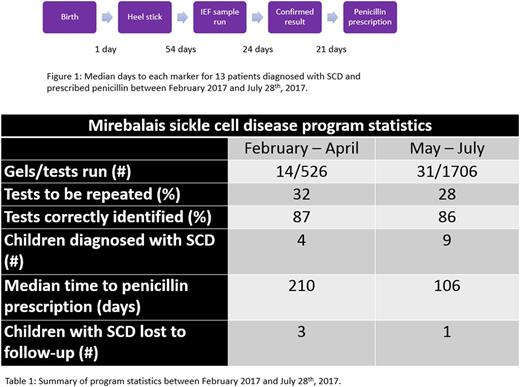Abstract
Background: In Haiti, nearly 1% of babies are born with sickle cell disease (SCD) and up to 90% will die before their fifth birthday. Despite a high prevalence and the knowledge that newborn screening and early intervention greatly reduce morbidity and mortality associated with the disease, no national newborn screening program exists in the country. While a SCD program that focuses on newborn screening and early treatment for children with SCD was established in Mirebalais, Haiti in 2014, it has struggled to provide regular and accurate screening that leads to babies returning for routine SCD care. We developed a pilot quality improvement (QI) initiative to improve the diagnosis and early follow-up of children with SCD in Haiti.
Objective: To increase by 20% the accuracy of SCD diagnosis by Haitian technicians and decrease the time to first penicillin prophylaxis prescription to 120 days or less for babies born at the University Hospital of Mirebalais within 6 months of start of QI initiative.
Methods: We performed a needs assessment of the University of Mirebalais SCD program consisting of interviews with key stakeholders. A Strength, Weaknesses, Opportunities, and threats analysis and process map were developed to identify areas of improvement. Rapid cycle changes were tested using QI methodology based on Plan, Do, Study, Act cycles to streamline the process. Key interventions included: training of on-site laboratory technicians in isoelectric focusing (IEF) and nursing in care coordination every 3 months, review of every test and result by US based IEF consultant and nursing director, and creation of a shared database to track patient progress through our screening to follow-up process.
Results: We compared the first 3 months of our study period (February to April 2017) to that of the next 3 months of the study period (May to July 2017). The number of gels run increased from 14 from February to April to 31 from May to July. We also found a reduction in the number of tests that needed to be repeated due to improperly run tests (32% to 28%), despite an increase in the total number of tests run (526 to 1706) and sustained accuracy in identifying IEF bands above 85%. 13 children were diagnosed with SCD. 3 patients could not be found and 1 died. Of the 9 patients contacted, the median time from screening date to start of penicillin was 109 days. This improved from 210 days in the first 3 months of the study period to 106 in the last 3 months of the study period.
Conclusions: Training of technicians every 3 months greatly improved outcomes of IEF SCD diagnosis. The accuracy of SCD diagnosis did not improve but we increased the number of tests run while maintaining high accuracy at greater than 85%. The lack of patient contact information and slow turnaround of sample results influenced patient follow-up rates and the number of patients lost to follow-up. Improvement in time from heel stick to confirmation of IEF result and employment of community health workers when patient contact information is incomplete may improve follow-up.
No relevant conflicts of interest to declare.
Author notes
Asterisk with author names denotes non-ASH members.


This feature is available to Subscribers Only
Sign In or Create an Account Close Modal